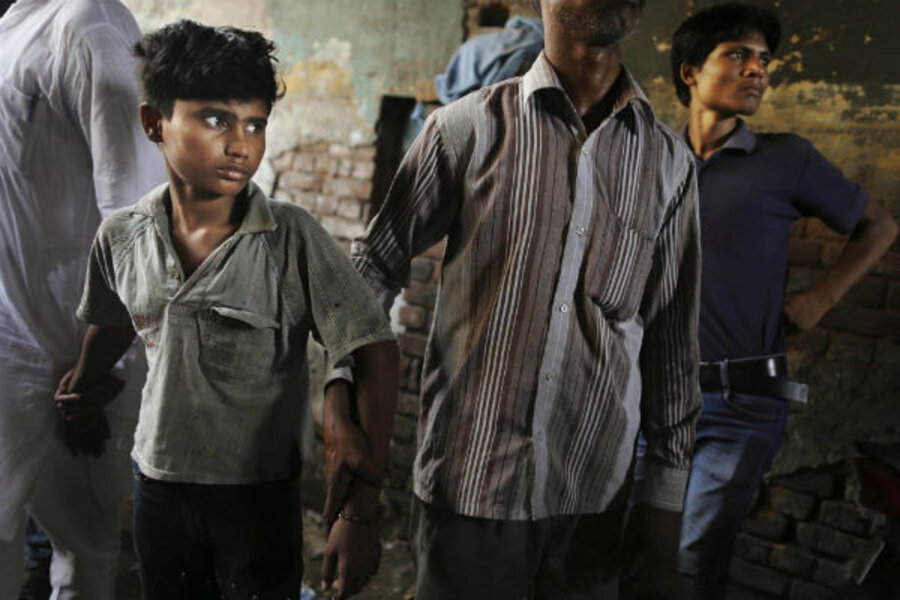How do you contribute to modern day slavery of human trafficking?
Loading...
In this week's Monitor cover story on the misunderstood scourge of human trafficking, some human rights advocates suggest that the global problem gets eclipsed by the issue of domestic sex trafficking. Forced labor is a part of the problem that is less publicized. If in the United States "human trafficking" is equated with sex, they argue, Americans miss the global problem.
COVER STORY: Human trafficking – a misunderstood global scourge.
To highlight the overall problem, the US State Department offers a run-down of some of the intersections of American life and global involuntary servitude. In a typical day, Americans can wear, use, and consume items made or processed by men, women, and children in what the agency calls "modern day slavery." While there is growing public awareness of fair-trade labeling that may help consumers avoid goods affected by trafficking, the State Department sponsors an interactive website – http://slaveryfootprint.org – that allows you to calculate "how many slaves work for you" based on your consumption patterns . The site also offers ways consumers can help reduce human trafficking.
6 A.M. GET READY FOR WORK:
The clothes on your back could have been produced by a man, woman, or child in a garment factory in Asia, the Middle East, or Latin America who is subjected to forced labor, including withholding of passports, no pay, long working hours to meet quotas, and physical and sexual abuse. To complete your outfit, the jewelry you put on this morning may include gold mined by trafficked children in Africa, Asia, and Latin America.
8 A.M. AT YOUR DESK:
The electronics you use may be dependent on minerals produced in conflict-affected areas in Africa where children and adults are forced to work in mines under conditions of forced labor and sexual servitude. The electronic devices you use may also be produced in Asia by adults and children – some as young as 9 – who are sold or deceived into working in electronic factories under conditions of forced labor, including excessively long hours, minimal or no pay, and threats.
10 A.M. COFFEE BREAK:
The coffee you drink may have been processed by modern slaves. Some men and children work under conditions of forced labor on coffee plantations in Latin America and Africa. The sugar you put in that coffee may have also come from plantations where children and men in Latin America, Asia, and Africa are sub-jected to conditions of forced labor and debt bondage.
12 P.M. LUNCH:
The fish you eat for lunch may have been caught by men in Southeast Asia and children as young as 4 in West Africa who are subjected to conditions of forced labor in the fishing industry. These victims may have been deprived of wages, food, water, and shelter, worked extremely long hours, and suffered physical and sexual abuse.
2 P.M. AFTERNOON SNACK:
The chocolate dessert you eat may have involved modern slaves, primarily in Africa. Children who work on plantations that produce cocoa – the key ingredient in chocolate – are subjected to conditions of forced labor. An estimated 300,000 children work in cocoa production worldwide.
4 P.M. DRIVE TO A MEETING:
The tires on your car are made of rubber, which is produced in Asia and Africa on rubber plantations. Adults and children – sometimes entire families – are forced to work on these plantations for little to no pay, for excessive hours to meet quotas, and in hazardous working conditions.
6 P.M. ARRIVE HOME:
The bricks in the walls of your house may have been produced by bonded labor victims, including men, women, and children, in brick kilns primarily in Asia and Latin America. Children and adults are forced to work in hazardous working conditions in brick kilns for long hours and minimal pay.
8 P.M. EAT DINNER:
The food you cook and eat for dinner may have been brought to you by men and children subjected to forced labor on cattle ranches and farms in the US, Latin America, and Africa. These victims work long hours, receive little or no pay, and suffer physical and emotional abuse to herd the cattle.
11 P.M. GO TO BED:
The cotton in your bedroom may have been picked by men, women, and children – some as young as 3 – in cotton fields, primarily in Central Asia and Africa. Children are forced to leave school to work under arduous and abusive conditions, sometimes with no pay, during the annual cotton harvest.







